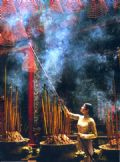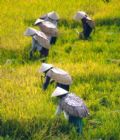|
|

“Joy”
by Thuc Trinh.

“Down
the River”
by Nguyen Van Dung.

“Pray
for happiness” by Dao Tien Dat.

“To
the market”
by Bui Van Thanh.

“Laugher of water”nbsp;
by Hung Hoa Lu.

nbsp;“Harvest time”
by Pham Van
Ty.
| Photography
came to Vietnam in 1869 with the opening of the Cam Hieu Duong photo shop
in Thanh Ha Street (Hanoi) by Dang Huy Tru. Then it contributed its part
in keeping Vietnamese people’s tradition of filial piety, i.e taking
photographs for worship in the family.

“Market day” by Dung
Nguyen.
In the late 19th and
early 20th centuries, there were
collections of photos about life of the mandarins, old streets and daily
life of the Vietnamese people. With the application of Iconographie,
photography was more widely popularized.
In big
cities like Hanoi and Saigon (present-day Ho Chi Minh City), there were
more people taking photos as a hobby and other amateur photographers
taking artistic photos.
Great
changes in Vietnam, including the two resistance wars for national
independence against the French colonialists and American imperialists,
helped photography quickly fix its position and a tendency of
photographing social events was built.
The event
that marked the development of Vietnamese photography was the issuance of
the decree to establish Vietnam National Enterprise for Cinematography and
Photography by President Ho Chi Minh on March 15, 1953, at Viet Bac
resistance base. Later, that day was celebrated as Vietnamese
Photographers’ Day.
On February
20, 1958, the Vietnam Photographic Artists’ Liaison Committee was
established which attracted capable photographers nationwide in the fields
of photographic creation and press. It is the predecessor of the
present-day Vietnam Photographic Artists’ Association (VAPA).
In December
1965, VAPA was officially celebrated, marking the development in quality
of Vietnamese photography. It is the biggest photographic organization of
the country and a member of the Federation of International Photographic
Artists (FIAP).
So far,
VAPA has convened five congresses and its Sixth Congress will be held in
March 2005. VAPA has now more than 600 members from more than 60 cities
and provinces nationwide. Most of them are working for press and mass
media organizations, and the rest as amateur photographers. Their works
were highly appreciated at FIAP-sponsored photo exhibitions, and many of
them were awarded A.FIAP and E.FIAP titles.
In the new
stage of development, photography has many changes in both content and
form. With development of software programmes, there are photos taken with
the photographer’s intention, which marks the approaching and interference
between photography and graphics. Some of these photos won awards at
national contests for this theme.
However,
the main direction of Vietnamese photography is that of social photography
that closely follows great changes in life. Truthfully with its
characteristics, i.e. recording the truth and respecting the flow of the
events, the photographers reflect vividly the life with diverse
activities. The breath of life comes into the photos, bringing fresh and
perspective images through a pure and inclined-to-the-good view.
Photography has enriched the visual channel of creation and becomes an
indispensable spiritual food in the life of Vietnamese art-loving
people.
Story: Vu Duc
Tan |